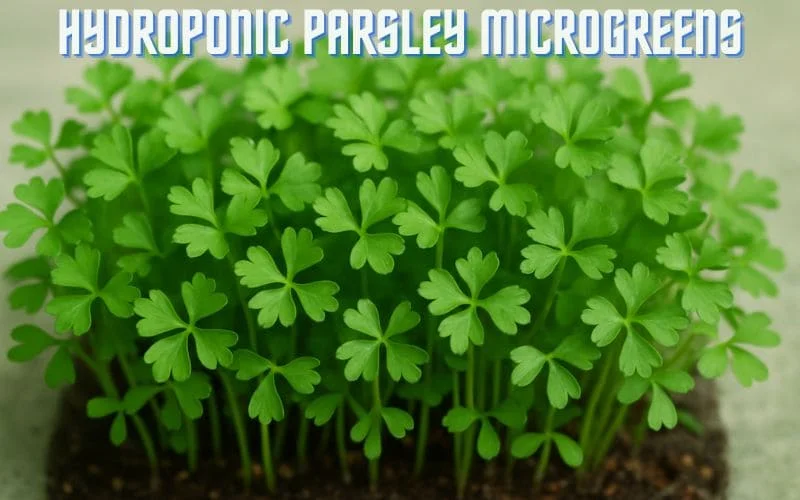Hydroponic Parsley Microgreens: Step-by-Step Indoor Guide

Introduction
Welcome to our blog post about Hydroponic Parsley Microgreens. In this comprehensive guide, we will explore the fascinating world of hydroponic soilless agriculture, with a specific focus on the growth and benefits of parsley microgreens. Whether you are a seasoned grower or a novice enthusiast, this article will provide valuable insights, tips, and techniques to help you cultivate healthy and vibrant hydroponic parsley microgreens.
What are Hydroponic Parsley Microgreens?
Hydroponic parsley microgreens are the young, tender shoots of the parsley plant grown in a soilless, water-based system enriched with nutrients. Typically harvested within 14 to 21 days, these vibrant greens are cultivated under controlled indoor conditions using grow lights and mediums like coconut coir or vermiculite. Visually, hydroponic parsley microgreens have slender, pale-green stems topped with delicate, bright green leaves that begin to take on the classic curly or flat-leaf shape of mature parsley. They offer a fresh, bold parsley flavor—more intense than mature leaves—and are packed with vitamins A, C, and K. Because they’re grown hydroponically, they’re cleaner, more consistent, and perfect for small spaces, making them a popular choice for chefs, home growers, and health-conscious eaters.
How to Grow Hydroponic Parsley Microgreens
🌱 Materials You’ll Need
| Item | Description |
|---|---|
| Parsley Seeds | Use organic, untreated seeds (curly or flat-leaf varieties). |
| Shallow Growing Tray | 1–2 inches deep; with or without drainage holes (depends on system). |
| Growing Medium | Coconut coir, hemp mats, or vermiculite work best. |
| pH-Balanced Water | Ideal pH: 5.5–6.0. Use a pH meter or pH test kit to adjust if needed. |
| Hydroponic Nutrient Solution | Balanced microgreen or general hydroponic formula. |
| Spray Bottle | For misting seeds and maintaining moisture. |
| Grow Lights | LED full-spectrum grow lights (12–16 hrs/day if no strong sunlight). |
| Dome or Humidity Cover | Optional but useful during germination (1st 3–5 days). |
| pH & EC Meter (optional) | For precise nutrient management. |
✅ Best Hydroponic Systems for Parsley Microgreens
| System Type | Why It’s Good |
|---|---|
| Coco Coir in Trays | Simple, beginner-friendly, and affordable. Great for parsley’s slower germination. |
| NFT (Nutrient Film Technique) | Good for larger operations but requires more setup. Avoid for basic home use. |
| Hydroponic Mats (Biostrate/Hemp) | Clean, consistent growth. Pairs well with shallow trays and misting. |
| Kratky Method | Works well with leafy greens, but parsley is slower-growing and less ideal. |
Best overall choice for home growers:
👉 Shallow grow tray with coconut coir or hemp mat using top watering (mist or pour).
🌿 Step-by-Step Instructions
1: Soak Your Seeds (Optional but Recommended)
Parsley seeds can be slow to germinate. Soaking speeds things up.
-
Soak seeds in lukewarm water for 6–8 hours.
-
Drain and rinse before sowing.
2: Prepare Your Tray
-
Place your growing medium (e.g., coconut coir) in a shallow tray.
-
Moisten it with pH-balanced water—it should be damp, not soggy.
3: Sow the Seeds
-
Evenly spread parsley seeds over the surface.
-
Gently press them into the medium to ensure good contact.
-
Lightly mist with water to moisten the top layer.
4: Cover for Germination
-
Cover the tray with a humidity dome or a second tray to block light.
-
Place the tray in a warm, dark space (65–75°F) for 3–5 days.
-
Mist daily to maintain moisture.
5: Move to Light
-
Once seeds have germinated (you’ll see sprouting), remove the cover.
-
Move the tray under grow lights for 12–16 hours/day.
-
Maintain ambient temps around 65–75°F.
6: Water and Feed
-
Use a spray bottle to mist water or nutrient solution once or twice daily.
-
Every 2–3 days, water lightly with a diluted hydroponic nutrient solution (¼–½ strength).
-
Monitor moisture—keep the medium damp but not soggy.
7: Harvest
-
In 14–21 days, when microgreens reach 2–3 inches and show their first true leaves:
-
Use clean scissors to cut the greens just above the growing medium.
-
Rinse gently and pat dry with paper towels.
-
8: Store & Enjoy
-
Store in the refrigerator in a breathable container (like a clamshell with paper towel).
-
Use fresh within 5–7 days.
🛠️ Pro Tips
-
Use a fan for light air circulation to prevent mold.
-
Check pH and EC levels if you notice discoloration or poor growth.
-
Use bottom watering if mold is an issue—just add water to a second tray underneath.
Benefits of Hydroponic Parsley Microgreens
🌿 Nutritional Highlights of Hydroponic Parsley Microgreens
| Nutrient | Benefit |
|---|---|
| Vitamin C | Powerful antioxidant that supports immune function and skin health. |
| Vitamin K | Essential for blood clotting and bone health. Parsley microgreens are especially rich in it. |
| Vitamin A (Beta-Carotene) | Supports vision, immune defense, and cell growth. |
| Folate (Vitamin B9) | Important for DNA synthesis and cell repair, especially critical in pregnancy. |
| Iron | Aids in red blood cell production and prevents anemia. |
| Calcium | Vital for strong bones, teeth, and muscle function. |
| Chlorophyll | Known for detoxifying properties and promoting healthy skin and digestion. |
| Lutein and Zeaxanthin | Antioxidants that help protect eye health and reduce risk of age-related macular degeneration. |
| Essential Oils (Apiole, Myristicin) | Natural compounds in parsley that may offer anti-inflammatory and antioxidant effects. |
🧪 Additional Benefits
-
Low in Calories – Great for weight management.
-
Rich in Antioxidants – Helps combat oxidative stress.
-
Supports Detoxification – Natural diuretic properties may support kidney health.
-
Anti-inflammatory Properties – Thanks to high levels of apigenin and flavonoids.
🥗 Why Microgreens Are More Potent Than Mature Parsley
Because parsley microgreens are harvested early in their growth cycle—usually within 2–3 weeks—they contain higher concentrations of vitamins and minerals per gram than fully grown parsley leaves. A study from the USDA even showed that microgreens can have up to 5 times the nutrient density of mature vegetables.
Harvesting and Using Hydroponic Parsley Microgreens
🕒 When to Harvest
-
Parsley microgreens are ready to harvest in 14 to 21 days after sowing.
-
Look for:
-
2–3 inches in height
-
The appearance of the first set of true leaves (the second pair of leaves that emerge after the seed leaves, or cotyledons).
-
A vibrant, bright green color and sturdy stems.
-
✂️ Step-by-Step Harvesting Instructions
-
Sanitize your scissors or harvest knife with rubbing alcohol or hot water.
-
Hold the stems gently with one hand to keep them upright.
-
Cut just above the growing medium, about ½ inch from the base—avoid pulling the roots or disturbing the growing surface.
-
Collect the cut microgreens in a clean bowl or container.
-
Optionally, rinse gently with cool water to remove any debris or seed hulls.
-
Dry them on a paper towel or salad spinner to remove excess moisture before storage or use.
💡 Tip: Harvest in the early morning when the greens are most hydrated and flavorful.
🧊 How to Store Freshly Harvested Microgreens
-
Refrigerate immediately in a breathable container (like a clamshell with a paper towel).
-
Use within 5–7 days for best flavor and nutrition.
-
Avoid airtight containers—they can trap moisture and cause spoilage.
🍽️ Ways to Use Parsley Microgreens in the Kitchen
Hydroponic parsley microgreens have a bold, clean parsley flavor—like mature leaves, but more concentrated and tender.
🥗 Add Them To:
-
Salads – Mix with other microgreens or leafy greens.
-
Sandwiches & Wraps – Use as a fresh, peppery garnish.
-
Smoothies or Juices – A mild herbal twist to green drinks.
-
Soups – Sprinkle on top just before serving for vibrant color and flavor.
-
Eggs & Omelets – Fold into scrambled eggs or garnish over frittatas.
-
Grain Bowls & Stir-Fries – Add a raw handful post-cooking for freshness.
-
Pasta & Risottos – Stir in at the end or use as a finishing herb.
-
Garnish for Cocktails or Mocktails – Adds visual appeal and herbal aroma.
🍽️ Pro Tip: Because they’re so tender, parsley microgreens are best used raw or lightly added at the end of cooking to preserve their nutrients and bright flavor.
Conclusion
In conclusion, hydroponic parsley microgreens offer a convenient and rewarding way to cultivate fresh, nutrient-rich greens in a controlled indoor environment. Their rapid growth, compact size, and nutritional value make them an appealing choice for culinary enthusiasts, health-conscious individuals, and urban growers seeking sustainable and space-efficient cultivation methods.
By embracing the practice of hydroponic soilless agriculture, enthusiasts can explore the endless possibilities of growing a diverse array of herbs, vegetables, and microgreens, including the delightful and versatile hydroponic parsley microgreens.

